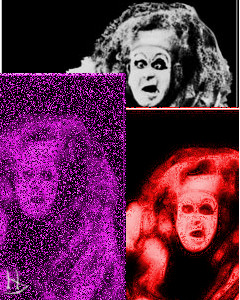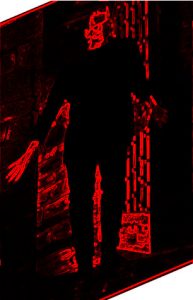
 OK, so 200 years ago, Mary Shelley published the remarkable novel Frankenstein. Certainly, a story for modernity and likely the first science fiction tale ever told.
OK, so 200 years ago, Mary Shelley published the remarkable novel Frankenstein. Certainly, a story for modernity and likely the first science fiction tale ever told.
Haj can not let this anniversary pass without some words – probably too many, but that’s for you to decide. Early on, Haj became a real fan of horror movies – all of them “oldies” now too. He considers himself somewhat of an expert on horror.
Frankenstein is likely one of the most influential works on Haj’s life too. One aspect that is so critical to this piece is the isolation of the creature and its commentary on the human condition.
A recent reading of the extraordinary and wonderful Truman Capote and his first novel, Other Voices, Other Rooms, offered a poignant passage from one of its characters (Randolph), “…we are alone, darling child, terribly, isolated each from the other; so fierce is the world’s ridicule we cannot speak or show our tenderness; for us, death is stronger than life, it pulls like a wind through the dark, all our cries burlesqued in joyless laughter; and with the garbage of loneliness stuffed down us until our guts burst bleeding green, we go screaming round the world, dying in our rented rooms, nightmare hotels, eternal homes of the transient heart.”
So what follows is the first of four parts of an exploration of Shelley’s novel that Haj actually prepared while completing his belated undergraduate degree December 12, 2008 and that he called, “The Monster in the Mirror”.
The Monster in the Mirror: Death and Dystopia in Mary Shelley’s Frankenstein
Frankenstein, by Mary Shelley, weaves a metaphorical tale that works, often ambiguously, on a number of levels. Critics have since pondered how an 18 year old English girl could write such a powerful and complex tale. Whether she had more than editorial assistance from her talented paramour Percy; drew inspiration from her pedigree and upbringing; or was the right woman in the right time to combine these advantages from a place that Yeats might call the Spiritus Mundi. Whatever her inspiration, the novel did draw from the well of civilization’s most powerful myths and stories, most obviously from Milton and Ovid, while something prophetic and starkly modern was being crafted. The gothic novel Frankenstein presents a secular retelling of the story of a fallen humanity’s search for redemption.
After assembling the necessary raw materials, Mary Shelley imbues her creation with the spark that seems to give the narrative a life of its own. Like her creature leading its master, the story tirelessly drags the reader into an abyss of inevitability. Echoing a timeless literary theme, Fate, it seems, will be fulfilled (Sutherland, lec. 1).
Even before the story begins, the reader is warned of the relationship between knowledge and a “fall” with the evocation of the two important creation myths of western civilization – the theft of fire by the Titan Prometheus suggested in the novel’s subtitle and the epigraph that quotes Milton’s influential epic retelling of the loss of innocence in Eden. Ambitious desires for an unearthly and secret knowledge bring about the downfall of Frankenstein and all that he loves. Pandora’s Box is opened, death enters the garden, and knowledge is exchanged for a soul.
Mary Shelley’s reconstituted dire warnings of intellectual ambition have resonated since they were first published in 1818. Europe was at a critical crossroads when the novel was first conceived. War and revolution had wracked the continent, Britain was beginning to industrialize, and firmly established Christian orthodoxy and entrenched Scholasticism were already being challenged by the Enlightenment. George Levine, in “The Ambiguous Heritage of Frankenstein”, places the novel where “the central dualities of a culture in which reason and science were displacing religion as the centers of value” (29). In “Frankenstein as Mystery Play”, Judith Wilt is more provocative by describing the novel as “painfully acting out under the nose of the Enlightenment a long line of expunged doctrines – Justification, Creation, Damnation – and unspeakable sacraments – Holy Orders, Confession, Communion” (32). The institutions of the past along with their beliefs would steadily be replaced with the steely spires of “a diseased ‘technological society’” that Frankenstein seemed to foreshadow like no other work of its time (Levine/Knoepflmacher xii).
Mary Shelley and her poet-companions in the summer of 1816 – Percy Shelley and Lord Byron – are said to belong to the Romantics. Romanticism was a direct reaction to Enlightenment thinkers and their claims of truths grounded in the material universe. The Romantics would view imagination, sensation or emotion as qualities as valuable (or possibly even more valuable) than Enlightenment rationale. Charles Woodard in his essay “The Archetype of the Fall” summarizes the Romantics as those who found “the present uninhabitable” and who believed “a more habitable world exists somewhere either in time or space” (580). As described by John Sutherland in his lectures “Classics of British Literature”, the Romantic revolution returned poetry to a primal and natural state (lec. 26). These artists, poets and thinkers dreamed of lost and mythical places of an idealized past or of the beauty and peace of nature unspoiled.
The explorer Walton and scientist Victor Frankenstein not only represent the Enlightenment’s search for truth in the material universe, but also demonstrate Romantic idealism. For scholars Michael Manson and Robert Scott Stewart writing in their essay “Heroes and Hideousness: ‘Frankenstein’ and Failed Unity”, artistic and scientific genius was linked through a “concomitant attribute of creative imagination” (231). Walton and Victor represent the Romanticism of the Enlightenment or the dreams of the scientific age. Victor is “a sublime quester” for Paul Sherwin who finds the connection of “Romantic faith in the omnipotence of thought” with “the scientist’s baleful drive for manipulative control” in his essay “Creation as Catastrophe” (894). Walton, whose narrative forms the outer layer of the novel, heads to the north pole searching for something “surpassing in wonders and beauty every region hitherto discovered on the habitable globe” in “a country of eternal light” (6). Victor, whose interest he himself terms “metaphysical”, searches “with a gladness akin to rapture” for the elixir of life – a reclamation of the fruit from the tree of life and the secret of creation that represents the key to the “physical secrets of the world” (36, 53). The enlightened explorers of Frankenstein, it seems, have inherited the dreams of their superstitious forefathers.
As Charles Woodard describes in his essay “The Archetype of the Fall”, a chasm that had opened between humanity’s unique capacity for reason and the more brutish sensations of a primeval existence would be “suddenly greatly widened by the special extension of the rational processes in the sciences” (579). All too human desires were to set overreaching humankind up for a second Fall. Walton wonders of Victor, “Do you share my madness” (24)? Indeed, both Walton’s search for an Arctic Xanadu and Victor’s god-like quest for eternity are realized as nightmares – of barren icy seas and the murderous plague of a demon.
While the intellectual Milton might wish to somehow excuse the theft of knowledge as humanity’s original sin, Mary Shelley’s story of a modern Prometheus permeates with the idea that “sorrow only increased with knowledge” (157, Sutherland lec. 12). Manson and Stewart argue that the “illusions of divinity” propelling the entirely modern “would-be” genius of the Romantic scientist/artist were “limited and constrained by the very finite conditions it tried to escape” and were doomed by the finitude of their medium – the imperfections and limitations of nature and their own place in a natural world (231). The Earth and all its denizens remain trapped in the mortal confinements of limited time and space. All of the artifices and creations of humankind are likewise imperfect and flawed. Visions of angels and demons, immortality and paradise are only dreams, after all.
Mary Shelley’s creation, like the Creature that moves through it, is “another ‘imperfect animation’” (Sherwin 898). Sherwin claims that the Monster’s “principal virtue is virtuality” for it is “a kind of wandering signifier” that ignites meanings that “multiply endlessly” (890). The novel is the Creature, the writer is the creator, Frankenstein is an artist, and the reader intimately participates in the “self-alienating labor that constitutes authorship” or the unholy reanimation of the dead (Sherwin 891, 894, 898-9, Woodard 580). As Levine and Knoepflmacher state in the preface to the volume The Endurance of Frankenstein, the images and story “enter both our private and culturally shared store of dream, fantasy, and myth” (xiii). Art, science and language are all the imperfect artifices of an imperfect humanity.
Language, for the Creature, is seen as “a godlike science” that is mirrored in the necromancy of Victor’s science and “for the first time in the novel Mary Shelley links language to the creation of the monstrous itself” (Lamb 312). For Wilt, the novel is the recurrence of “the same ecstatic despair before the old aesthetic paradox” of art and of Frankenstein’s science – in striving to achieve beauty the poet has only loosed upon the world “an image of death” (44). As John Lamb explains in “Mary Shelley’s Frankenstein and Milton’s Monstrous Myth”, while language is presented as some “transcendental” medium that can allow one to “master the monstrous” and escape the finitude of the mortal life, it is actually and ironically monstrous itself – language limits and is spawned from the limiting definitions of its “cultural hierarchy” (312). So as literature relies on the trickery of metaphor, irony and ambiguity, the Monster is defined by a culture that has not found a place (or a name) for him – he is either Adam or is Lucifer (Lamb 312, Sutherland lec 4). The consequences are not a mastery of the self, but the mastery of the self through the cultural forms pre-existent in language (Lamb 312). Monster, creator, and language can not be freed from the bonds or labels of an all too imperfect mortality. It is in his name – ‘Frankenstein’ is a “free rock” or the “free-unfree man” (Sherwin 894).
More to come – part one of four parts